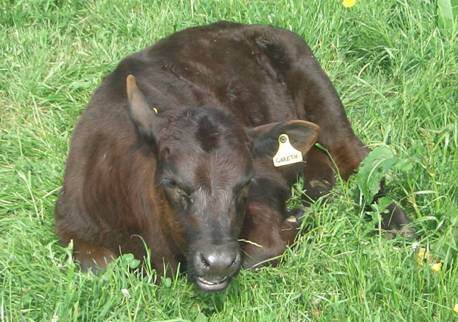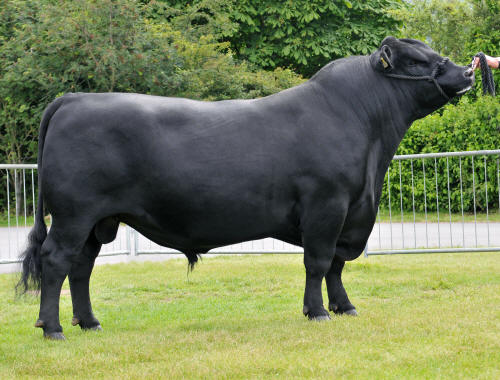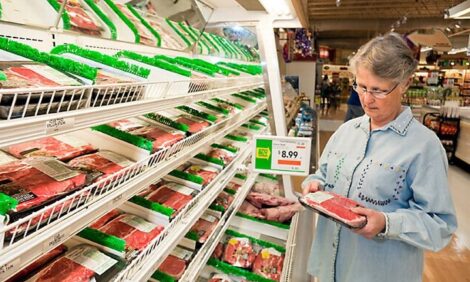



Using Genomics To Improve Business
One farmer in the UK aims to produce the perfect steak, and he is using genomics to do this. Charlotte Johnston, TheCattleSite junor editor speaks to Paul Westaway.Mr Westaway is passionate about genomics, which he believes is the next big step for the industry since AI.
He farms 140 acres of County Council farmland, in Dymock, Gloucestershire.
Blade Finishing Contract
The Westaways' finish 70 Angus cross Holstein calves a year for Blade Farming. Calves are brought onto the farm at 12 weeks old, and leave at 17-18 months of age at 530/540 kg liveweight.
Mr Westaway works to tight specifications, which is why Blade Farming pays him a guaranteed price per kg, providing these specifications are met. His target is a 260kg carcase, and the last 103 carcases have weighed in at 259.5kg!
The hindquarter of the animal is sold to Tescos, whilst the forequarter goes to McDonalds.
Genomics
The second part of the business is a 70 pedigree Angus herd.
All females are bred via artificial insemination (AI) from what Mr Westaway says "are the best bulls" in the world.
All heifer calves are kept back to go into the herd, whilst all bull calves are reared for breeding.
From these bull calves, one to two of them per year end up being used for AI. The rest remain as breeder bulls.
This is where genomics plays a large part for Mr Westaway's business. All bull calves are screened with a Pfizer 3000 chip marker, so that they possess genomic data.
This, says Mr Westaway, immediately increases the reliability of these bulls. The test costs between £30-40 per calf.
The top pile of these are screened using a 50,000 chip, which will determine those calves suitable for AI.
"The tests are fast and can be carried out a one-day old, a piece of tail hair will allow the DNA to be analysed," says Mr Westaway.
These tests are a bit more costly - at US$250 per head, the test must also be shipped to the US for analysis.

But what is the benefit of this?
The 50,000 marker for Angus cattle can help producers in breeding and rearing decisions. It is a DNA diagnostic test, which tests 50,000 single nucelotide polymorphisms. This equates to providing genomic predictions for 14 production, efficiency, yield and quality traits.
This information includes calving ease, average dairy gain, fat thickness and marbling - as well as many others.
It results in every animal tested been given a Molecular Value Prediction (MVP), which is the net profit per head.
For example, the highest MVP bull in Europe is four months old (and has been bred by Mr Westaway).
He is in the top one per cent for ribeye, top two per cent for carcase weight, top two per cent marbling score and top for per cent for fat content.
Gareth has a MVP of + £133/ carcase. This means that the profit per carcase for an animal sired by this bull would be £133 more than the average, or 51p/kg.
Another of Mr Westaway's bulls is Melview Goliath. He is ranked in the top 15 per cent for tenderness; the top 20 per cent for ribeye and the top 15 per cent for fat content and boasts an increased overall profit index of +£77, which means that profit margins from the progeny of this bull will increase by £77 per head, which on a 260kg carcase represents 29p per kg.

One of the issues that Pfizer is working to overcome in the UK, is that the MVP is set up to work in a US production based system - which is vastly different to UK production methods.
For Mr Westaway, the benefit of genomics is that when marketing his bulls, he can tell customers the expected MVP, ease of calving, meat tenderness - the list goes on.
For calf rearers, genomic knowledge can be used to target feeding for growth rates, feeding conversion efficiency or to choose calves with excellent meat marbling and tenderness.
Analysing breeding cows will allow any genomic data to be matched. For example, a breeding cow with average marbling but excellent tenderness, can be bred with a bull which has excellent marbling and average to excellent tenderness.
Current sire data available through AI is only 30 per cent reliable and is based upon parents achievements to date, says Mr Westaway. It takes a great number of years until progeny performance can be evaluated to find out accurate data for a sire.
Genomics doubles the reliability of getting it right, says Mr Westaway. For him, genomics is about presenting reliable data to buyers and increasing profit per head.
The future
Currently, the 50,000 marker is only available for Angus cattle. However, Mr Westaway hopes that by the end of the year Pfizer will have developed the markers for other breeds. "It is time consuming gathering the comparable data, " he says.
"This sort of technology is already used widely in the US and Australia, and uptake is proving popular in the UK. Forward thinking breed societies are on board," he said.
"Sustainable agriculture must be profitable, and genomics is a way of guaranteeing this" Mr Westaway concluded.


